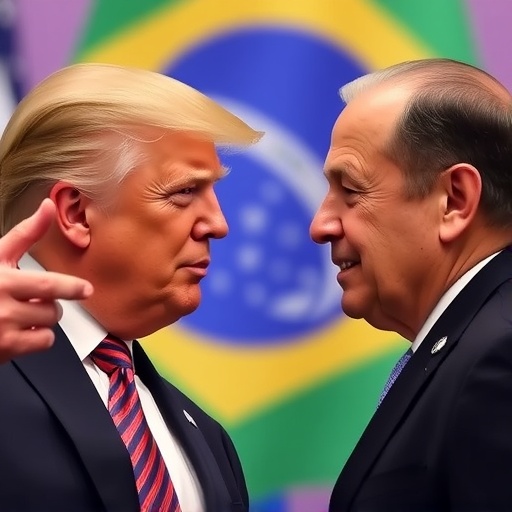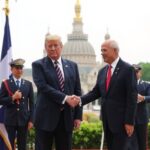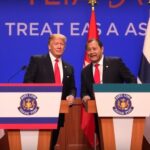US and Brazil Kick Off Urgent Tariff Talks After Trump-Lula Breakthrough at ASEAN Summit
In a stunning diplomatic pivot that could reshape hemispheric trade dynamics, Presidents Donald Trump and Luiz Inácio Lula da Silva emerged from a sideline meeting at the ASEAN summit in Jakarta with a handshake and a pledge for immediate tariff talks. The agreement, announced late Friday, signals a thaw in US-Brazil relations strained by years of escalating trade disputes, potentially unlocking billions in bilateral commerce.
- Trump-Lula Sideline Chat Sparks Tariff Thaw at ASEAN
- Flashpoints in US-Brazil Tariff Disputes: Steel, Soy, and Beyond
- Strategic Demands: What Washington and Brasília Want from Trade Negotiations
- High Stakes: Billions at Risk in US-Brazil Economic Interdependence
- Timeline and Horizons: Charting the Path Forward in Tariff Resolution
The surprise accord comes amid heightened global economic tensions, where tariffs have become a flashpoint between major economies. Trump, fresh off his reelection victory, touted the meeting as a ‘win for American workers,’ while Lula hailed it as a step toward ‘fairer global trade.’ This development not only eases immediate pressures on key industries but also sets the stage for broader trade negotiations between the two nations, which together represent over 10% of global GDP.
Details of the talks remain under wraps, but sources close to the negotiations indicate discussions will focus on steel, aluminum, soybeans, and aircraft sectors—flashpoints that have cost exporters on both sides hundreds of millions annually. With the first round of talks slated to begin within weeks, stakeholders from Washington to Brasília are buzzing with cautious optimism.
Trump-Lula Sideline Chat Sparks Tariff Thaw at ASEAN
The ASEAN summit, typically a forum for Asia-Pacific leaders, unexpectedly became the backdrop for a high-stakes bilateral encounter between Trump and Lula. Held on the summit’s second day, the 45-minute discussion—originally billed as a courtesy call—delved into the nitty-gritty of tariff talks, according to White House officials. Trump, known for his aggressive trade stance, surprised observers by emphasizing mutual benefits over confrontation.
‘We had a great conversation with President Lula. Brazil is a tremendous partner, and we’re going to fix these tariffs right away,’ Trump said in a post-meeting statement, flanked by Trade Representative Robert Lighthizer. Lula, Brazil’s leftist leader navigating domestic economic woes, reciprocated with warmth: ‘This is about building bridges, not walls. US-Brazil relations are vital for our peoples’ prosperity.’
The meeting’s timing couldn’t be more fortuitous. US-Brazil trade volumes hit $120 billion in 2023, up 15% from the previous year, per US Census Bureau data. Yet, punitive tariffs—imposed by Trump in his first term on Brazilian steel and aluminum—have lingered, prompting retaliatory measures from Brasília on US goods like whiskey and motorcycles. These barriers have inflated costs for US manufacturers reliant on Brazilian imports and squeezed Brazilian exporters facing reduced market access.
Diplomatic insiders reveal the breakthrough was facilitated by backchannel communications in the weeks leading up to ASEAN. Brazilian Foreign Minister Mauro Vieira, who accompanied Lula, noted that ‘both leaders recognized the absurdity of letting politics derail economics.’ This personal diplomacy echoes historical US-Brazil ties, from Cold War alliances to the Obama-era Open Government Partnership, underscoring the resilience of the partnership despite ideological divides.
Flashpoints in US-Brazil Tariff Disputes: Steel, Soy, and Beyond
At the heart of the upcoming trade negotiations lie deep-seated tariff disputes that have festered since 2018. Trump’s initial tariffs on Brazilian steel (25%) and aluminum (10%) were justified as national security measures, but critics argued they were protectionist ploys amid the US-China trade war. Brazil, the world’s second-largest steel producer, retaliated with tariffs on $300 million worth of US products, hitting agricultural exports hard.
Fast-forward to today: The steel sector alone accounts for over $5 billion in annual bilateral trade, according to the International Trade Centre. US firms like Nucor and Cleveland-Cliffs have lobbied for relief, citing how Brazilian duties have raised input costs by up to 20%. On the flip side, Brazilian steel giants such as Gerdau and CSN face dumped imports from Asia, making US tariffs a double-edged sword.
Agriculture adds another layer of complexity. Brazil, a soybean powerhouse exporting $30 billion annually, has seen US tariffs disrupt supply chains. In 2022, retaliatory Brazilian duties on US corn and cotton led to a 12% dip in US farm exports to Brazil, per USDA figures. ‘These tariffs are choking our farmers,’ said American Farm Bureau Federation President Zippy Duvall in a recent op-ed. Lula’s administration, pushing agribusiness as an economic engine, views tariff relief as essential for job creation in rural Brazil, where unemployment hovers at 8%.
The aircraft industry rounds out the big three. Boeing and Brazil’s Embraer have long sparred over subsidies, with WTO rulings favoring Brazil in some cases. Recent tariffs on regional jets have stalled deals worth $2 billion. Trade experts like Gary Hufbauer from the Peterson Institute for International Economics predict that resolving these could boost US-Brazil relations by injecting $10-15 billion into combined economies over five years.
To illustrate the human impact, consider the story of Maria Santos, a steelworker in São Paulo. ‘Tariffs mean fewer orders, fewer shifts. My family feels it every payday,’ she told Reuters. Similarly, in Ohio, US steelworker Tom Reilly echoed, ‘We need fair trade, not free-for-all dumping.’ These voices underscore the urgency driving Trump and Lula da Silva toward resolution.
Strategic Demands: What Washington and Brasília Want from Trade Negotiations
As tariff talks gear up, each side is laying out clear red lines and olive branches. The US, under Trump’s ‘America First’ banner, demands stricter rules of origin to curb Chinese steel rerouted through Brazil—a concern amplified by recent Commerce Department probes revealing 30% of Brazilian imports contain Asian components.
Key US asks include quota systems for steel imports and enhanced intellectual property protections for US agrotech firms operating in Brazil. Lighthizer, Trump’s trade czar, emphasized in a briefing: ‘We’re not lifting tariffs without assurances that Brazil enforces fair play.’ This aligns with broader US efforts to diversify supply chains away from China, with Brazil positioned as a key alternative.
Brazil, meanwhile, seeks tariff reciprocity and market access for its ethanol and beef exports. Lula’s team, advised by Economy Minister Fernando Haddad, is pushing for exemptions on environmental tariffs, arguing Brazil’s Amazon policies already meet global standards. ‘Trade negotiations must respect our sovereignty on sustainability,’ Haddad stated during a Brasília presser.
Broader US-Brazil relations factor in too. Beyond tariffs, talks may touch on digital trade, where Brazil resists US Big Tech dominance, and energy cooperation, given Brazil’s offshore oil boom. A joint statement post-ASEAN hinted at including labor and environmental chapters, potentially mirroring the USMCA model.
Stakeholders are mobilizing. The US Chamber of Commerce urged swift action, warning delays could cost 50,000 jobs. In Brazil, the National Confederation of Industry (CNI) polled members, with 70% favoring deeper integration. Quotes from experts abound: ‘This is a litmus test for Trump’s trade diplomacy,’ said Brookings Institution analyst Shannon K. O’Neil. Lula’s progressive base, wary of concessions, will watch closely as negotiations unfold.
High Stakes: Billions at Risk in US-Brazil Economic Interdependence
The economic ripple effects of successful tariff talks could be profound. Bilateral trade, already robust, stands to grow by 25% if barriers fall, per World Bank projections. For the US, easing tariffs means cheaper inputs for auto and construction sectors, potentially saving manufacturers $1.2 billion yearly, according to a 2023 PwC study.
Brazil’s gains are equally vital. With GDP growth projected at 2.5% for 2024 by the IMF, tariff relief could add 0.5 percentage points, bolstering Lula’s reelection bid in 2026. Key sectors like mining—Brazil supplies 20% of US iron ore—stand to benefit, as do renewables, where US firms eye Brazilian lithium for EV batteries.
Yet risks loom. Failure could escalate tensions, inviting WTO challenges or new barriers. Global context matters: With the EU imposing its own carbon tariffs, US-Brazil alignment could counter multilateral fragmentation. Statistics paint a vivid picture: US exports to Brazil support 400,000 jobs, while Brazilian firms employ 100,000 Americans indirectly, per US Trade Representative data.
Investor sentiment is shifting. Post-ASEAN, Brazil’s Bovespa index rose 3%, and US steel stocks like US Steel gained 2.5%. ‘Tariff talks are a green light for cross-border deals,’ noted JPMorgan analyst Maria Paula Aguiar. Stories from the ground, like Florida citrus growers eyeing Brazilian markets or Texas energy execs scouting Petrobras partnerships, highlight the human-scale opportunities.
In a nod to inclusivity, both leaders committed to involving civil society. US labor unions, via the AFL-CIO, demand enforceable worker standards, while Brazilian indigenous groups push for anti-deforestation clauses in trade pacts.
Timeline and Horizons: Charting the Path Forward in Tariff Resolution
With momentum building, the roadmap for trade negotiations is taking shape. Initial talks are set for mid-December in Washington, followed by a working group in São Paulo by January. Aiming for a framework by Q2 2025, negotiators hope to mirror the speed of the US-Japan mini-deal in 2019.
Potential outcomes range from full tariff elimination to phased reductions tied to benchmarks, like Brazil’s WTO compliance. Trump teased ‘the biggest trade win yet,’ while Lula’s office projected ‘mutual prosperity.’ Challenges persist—Congressional approval for any US concessions could snag, and Brazil’s fiscal austerity might limit concessions.
Looking ahead, resolved tariffs could catalyze deeper US-Brazil relations, from joint infrastructure projects under the Americas Partnership for Economic Prosperity to coordinated stances at the 2025 G20 in Brazil. As global trade wars rage, this bilateral push offers a model for pragmatic diplomacy. For businesses and workers on both sides, the message is clear: Relief is on the horizon, promising stability in an uncertain world.
Stakeholders should monitor updates from the Office of the US Trade Representative and Brazil’s Ministry of Economy. With billions hanging in the balance, the Trump-Lula accord marks not just an end to disputes, but a new chapter in hemispheric economic synergy.








